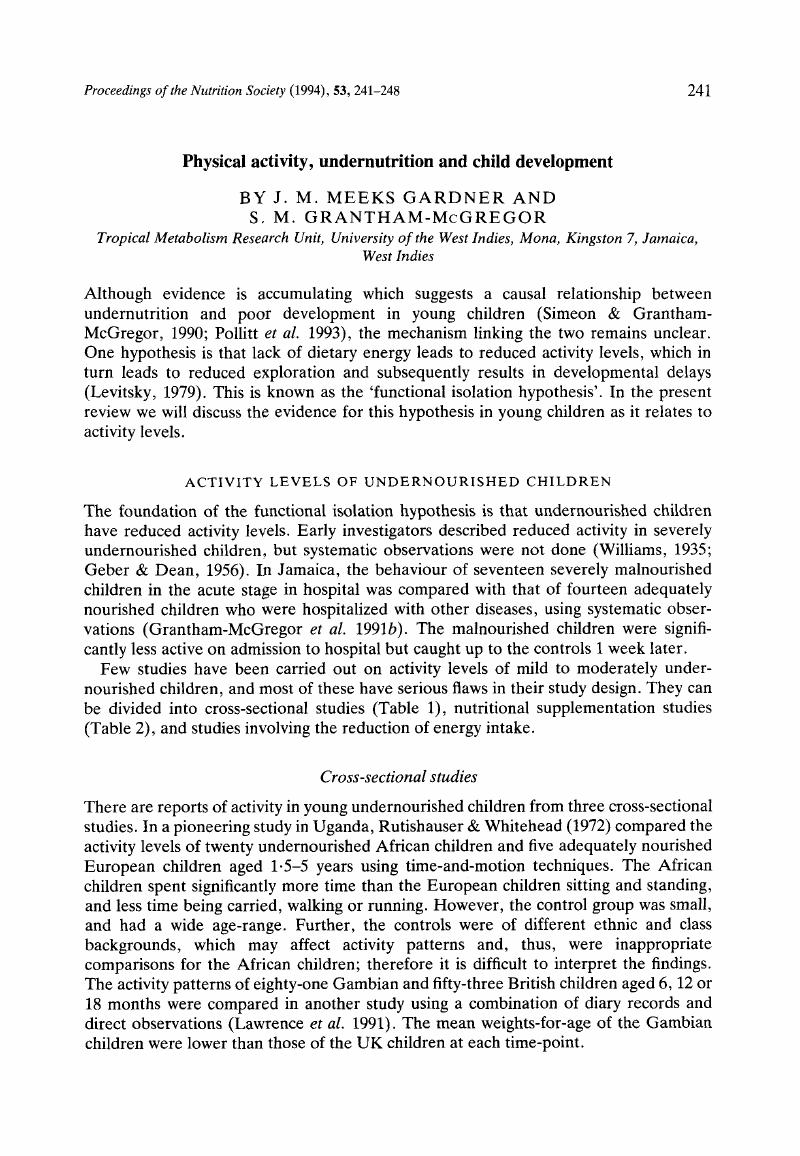Physical activity, undernutrition and child development | Proceedings of the Nutrition Society | Cambridge Core (original) (raw)
Abstract
An abstract is not available for this content so a preview has been provided. As you have access to this content, a full PDF is available via the ‘Save PDF’ action button.

References
Barrett, D. E. & Radke-Yarrow, M. (1985). Effects of nutritional supplementation on children's responses to novel frustrations and competitive situations. American Journal of Clinical Nutrition 42, 102–120.Google Scholar
Chavez, A. & Martinez, C. (1982). Growing Up in a Developing Community. Guatemala: INCAP.Google Scholar
Chavez, A., Martinez, C. & Bourges, H. (1972). Nutrition and development of infants from poor rural areas 2. Nutritional level and physical activity. Nutrition Reports International 5, 139–144.Google Scholar
Geber, M. & Dean, R. F. (1956). The psychological changes accompanying kwashiorkor. Courrier du CNRS 6, 6–15.Google Scholar
Grantham-McGregor, S., Meeks Gardner, J., Walker, S. & Powell, C. (1990). The relationship between undernutrition, activity levels and development in young children. In Activity, Energy Expenditure and Energy Requirements of Infants and Children, pp. 361–384 [Schurch, B. and Scrimshaw, N., editors]. Lausanne: IDECG/Nestlé Foundation.Google Scholar
Grantham-McGregor, S. M., Powell, C. A., Walker, S. P. & Himes, J. H. (1991 a). Nutritional supplementation, psychosocial stimulation and development of stunted children: The Jamaican study. Lancet 338, 1–5.CrossRefGoogle ScholarPubMed
Grantham-McGregor, S., Stewart, M. & Powell, C. (1991 b). Behaviour of severely malnourished children in a Jamaican hospital. Developmental Medicine & Child Neurology 33, 706–714.Google Scholar
Hamill, P. V. V., Drizol, T. A., Johnson, C. L., Reed, R. B. & Rock, A. F. (1977). Growth curves for children, birth–18 years. Vital and Health Statistics series vol. II, no. 165. (CDHEW publication no. 78) Hyatsville, MD, USA: National Centre for Health Statistics.Google Scholar
Keller, W. (1988). The epidemiology of stunting. In Linear Growth Retardation in Less Developed Countries. Nestlé Nutrition Workshop no. 14, pp. 17–40 [Waterlow, J. C., editor]. New York: Raven Press.Google Scholar
Lawrence, M., Lawrence, F., Durnin, J. V. G. A. & Whitehead, R. G. (1991). A comparison of physical activity in Gambian and UK children aged 6–18 months. European Journal of Clinical Nutrition 45, 243–252.Google ScholarPubMed
Levitsky, D. A. (1979). Malnutrition and hunger to learn. In Malnutrition, Environment and Behaviour [Levitsky, D. A., editor]. Ithaca: Cornell University Press.Google Scholar
Gardner, Meeks J. M., Grantham-McGregor, S. M., Chang, S. M. & Powell, C. A. (1990). Dietary intake and observed activity of stunted and non-stunted children in Kingston, Jamaica. Part II: Observed activity. European Journal of Clinical Nutrition 44, 585–593.Google ScholarPubMed
Pollitt, E., Gorman, K., Engle, P., Martorell, R. & Rivera, J. (1993). Early supplementary feeding and cognition: Effects over two decades. Monographs of the Society for Research in Child Development no. 235.Google Scholar
Rutishauser, I. E. & Whitehead, R. G. (1972). Energy intake and expenditure in 1-3-year-old Ugandan children living in a rural environment. British Journal of Nutrition 28, 145–152.CrossRefGoogle Scholar
Simeon, D. & Grantham-McGregor, S. (1990). Nutritional deficiencies and children's behaviour and development. Nutrition Research Reviews 3, 1–24.Google Scholar
Spurr, G. B. & Reina, J. C. (1987). Marginal malnutrition in school-aged Colombian girls: Dietary interventions and daily energy expenditure. Human Nutrition: Clinical Nutrition 41C, 93–104.Google Scholar
Spurr, G. B. & Reina, J. C. (1988). Patterns of daily energy expenditure in normal and marginally undernourished school-aged Colombian children. European Journal of Clinical Nutrition 42, 819–834.Google Scholar
Spurr, G. B., Reina, J. C. & Barac-Nieto, M. (1986). Marginal malnutrition in school-aged Colombian boys: metabolic rate and estimated daily energy expenditure. American Journal of Clinical Nutrition 44, 113–126.Google Scholar
Super, C. M., Clement, J., Vuori, L., Christiansen, N., Mora, J. O. & Herrera, M. G. (1981). Infant and caretaker behaviour as mediators of nutritional and social intervention in the barrios of Bogota. In Culture and Early Intervention, pp. 171–188 [Feildt, T., Sostek, A., Vietze, P. and Leiderman, P., editors]. Hillsdale NJ: Earlbaum.Google Scholar
Torun, B. (1990). Short- and long-term effects of low or restricted energy intakes on the activity of infants and children. In Activity, Energy Expenditure and Energy Requirements of Infants and Children, pp. 335–358 [Schurch, B. and Scrimshaw, N. S., editors]. Lausanne: IDECG/Nestlé Foundation.Google Scholar
Torun, B. & Viteri, F. E. (1981). Energy requirements of pre-school children and effects of varying energy intakes on protein metabolism. In Protein–Energy Requirements of Developing Countries: Evaluation of New Data. UNU Food and Nutrition Bulletin, Suppl. 5, pp. 229–241 [Torun, B., Young, V. R. and Rand, W. M., editors].Google Scholar
Viteri, F. E. & Torun, B. (1981). Nutrition, physical activity and growth. In The Biology of Normal Human Growth, pp. 265–273 [Ritzen, M., Aperia, A., Hall, K., Larsson, A., Zetterberg, A. and Zetterstrom, R., editors]. New York: Raven Press.Google Scholar
Walker, S., Powell, C., Grantham-McGregor, S., Himes, J. & Chang, S. (1991). Nutritional supplementation, psychosocial stimulation and growth of stunted children: the Jamaican Study. American Journal of Clinical Nutrition 54, 642–648.Google Scholar